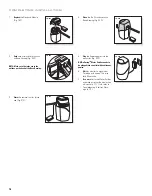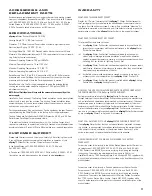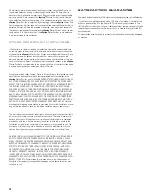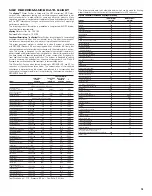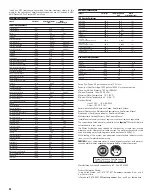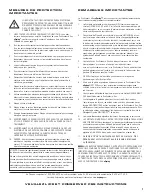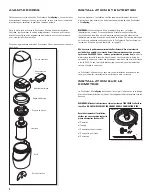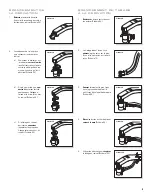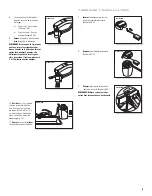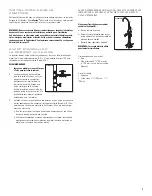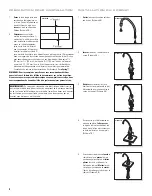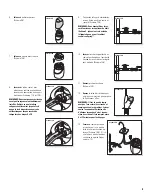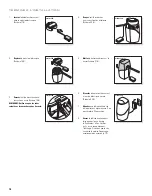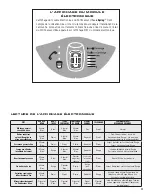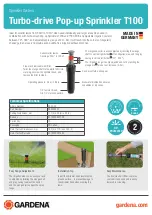
NSF PERFORMANCE DATA SHEET
The
eSpring
™
Water Purifi er is listed with the NSF International. NSF Inter-
national is an independent testing and certifi cation agency established to set
quality standards for a wide variety of home and industrial products. Many
regulatory agencies, municipal water treatment offi cials and residential builders
look for NSF International listing as certifi cation that a product will meet high
performance standards.
The following product information is presented in compliance with NSF Interna-
tional disclosure requirements.
eSpring
Water Purifi er No.: 10-0185
Replaceable Cartridge No.: 10-0186
Functional Description:
The
eSpring
Water Purifi er is comprised of a compressed
activated carbon block fi lter, and an ultraviolet lamp. The fi lter is composed of
two outer non-woven pre-fi lters, and a layer of immobilized activated carbon.
This water treatment system is certifi ed as a class B system in compliance
with NSF/ANSI Standard 55 and is equipped with an ultraviolet (UV) lamp that
requires replacement at intervals in accordance with the manufacturer’s instruc-
tions. The system is designed for the supplemental bactericidal treatment of
either treated and disinfected public drinking water or other drinking water which
has been tested and deemed acceptable for human consumption by regional or
local health authorities having jurisdiction. The system is designed to reduce
normally occurring non-pathogenic or nuisance microorganisms only. Class B
Systems are not intended for the treatment of contaminated water.
This Water Purifi er has been tested according to NSF/ANSI 42, and 53 for
reduction of the substances listed below. The concentration of the indicated
substances in water entering the system was reduced to a concentration less
than or equal to the permissible limit for water leaving the system as specifi ed in
NSF/ANSI 42 and 53.
Reduction Requirements/
Average Influent
Average Effluent
Max. Permissible
Challenge
Level
Product Water
%
Substance Concentration
(Product
Water)
Concentration
Reduction
Required
Actual
NSF/ANSI Standard 42 Aesthetic Effects
Particulates-Class I
(#/mL at 0.5 to <1 micron)
>10,000
12,000,000
68,100
>85%
99.4
Chlorine Taste and Odor
(mg/L as chlorine)
2 ± 10%
2.0
<0.05
≥
50% >97.5
Chloramine (mg/L)
3 ± 10%
3.0
0.07
0.5
97.6
NSF/ANSI Standard 53 Health Effects
Asbestos (fibers/mL >10 µm)
10
4
-10
5
73,750
<170 >99%
>99.7
Lead at pH 6.5 (µg/L)
150 ± 10%
150
<1.0
10
>99.3
Lead at pH 8.5 (µg/L)
150 ± 10%
150
<1.0
10
>99.3
Mercury at pH 6.5 (µg/L)
6.0 ± 10%
5.8
<0.2
2.0
>96.5
Mercury at pH 8.5 (µg/L)
6.0 ± 10%
5.8
0.2
2.0
96.5
Alachlor (µg/L)
40 ± 10%
42
<1.0
2.0
>97.6
Atrazine (µg/L)
9 ± 10%
9.5
<0.5
3.0
>94.7
Benzene (µg/L)
15 ± 10%
14.67
<0.5
5.0
>96.5
Carbofuran (µg/L)
80 ± 10%
86
<1
40
>98.8
Carbon Tetrachloride (µg/L)
15 ± 10%
15.67
<0.5
5.0
>96.8
Chlordane (µg/L)
40 ± 10%
40
0.7
2.0
98.2
Chlorobenzene (µg/L)
2000 ± 10%
1950
<0.5
100
>99.9
2-4-D (µg/l)
210 ± 10%
215
0.18
70.0
99.9
Dibromochloropropane (µg/L)
4 ± 10%
3.6
<0.01
0.20
>99.7
o-Dichlorobenzene(µg/L) 1800
±
10%
1917 <1 600
>99.94
Endrin (µg/L)
6 ± 10%
5.9
<0.2
2.0
>96.6
Ethylbenzene (µg/L)
2100 ± 10%
2000
<1
700
>99.95
Ethylene dibromide (µg/L)
1 ± 10%
1.0
<0.01
0.05
>99.0
Heptachlor 80
±
10%
77
0.06
0.4
99.9
Heptachlor epoxide (µg/L)
4 ± 10%
4.2
<0.02
0.20
>99.5
Lindane (µg/L)
2 ± 10%
2.1
<0.02
0.20
>99.0
Methyl-tert-butyl ether (MTBE) (µg/L) 15 ± 10%
14.7
0.6
5.0
95.9
Methoxychlor (µg/L)
120 ± 10%
120
0.1
40.0
99.9
PCBs (Aroclor 1260) (µg/L)
10 ± 10%
10.1
<0.3
0.5
>97.0
Radon (pCi/L)
4000 ± 25%
4426
6.4
300
99.99
Simazine (µg/L)
12 ± 10%
11
<0.2
4
>98.2
Styrene (µg/L)
2000 ± 10%
2016
<0.5
100
>99.9
Tetrachloroehthylene (µg/L)
15 ± 10%
14.5
<0.5
5
>96.5
Toluene (µg/L)
3000 ± 10%
3067
1.06
1000
99.96
Total Trihalomethanes
(TTHMs as chloroform) (µg/L)
450 ± 20%
478
2.1
80.0
99.5
Toxaphene (µg/L)
15 ± 10%
14.5
<1
3.0
>93.1
2,4,5 TP (Silvex) (µg/L)
150 ± 10%
150
19.5
50.0
87.0
Trichloroethylene (µg/L)
300 ± 10%
298.3
<0.5
5
>99.8
†
VOC’s (µg/L) as chloroform
300 ± 10%
343
<0.5
95%
>99.8
Test Conditions: pH: 7.75, Pressure: 60 p.s.i., Flow Rate: 3.4 L/min
†
The following table sets forth allowable claims which can be made for drinking
water treatment units that have met the requirements for VOC reduction.
Organic Chemicals Included By Surrogate Testing
Influent Challenge
Maximum Effluent
Substance Level
(ppb)
Level
(ppb)
Alachlor 50
1.0
Atrazine 100
3.0
Benzene 81
1.0
Carbofuran 190
1.0
Carbon tetrachloride
78
1.8
Chlorobenzene 77
1.0
Chloropicrin 15
0.2
2,4-D 110
1.7
Dibromochloropropane (DBCP)
52
0.02
o-Dichlorobenzene 80
1.0
p-Dichlorobenzene 40
1.0
1,2-Dichloroethane 88
4.8
1,1-Dichloroethylene 83
1.0
cis-1,2-Dichloroethylene 170
0.5
trans-1,2-Dichloroethylene 86 1.0
1,2-Dichloropropane 80
1.0
cis-1,3-Dichloropropylene 79
1.0
Dinoseb 170
0.2
Endrin 53
0.59
Ethylbenzene 88
1.0
Ethylene dibromide (EDB)
44
0.02
Haloacetonitriles (HAN):
bromochloroacetonitrile
22
0.5
dibromoacetonitrile
24
0.6
dichloroacetonitrile
9.6
0.2
trichloroacetonitrile
15
0.3
Haloketones (HK):
1,1-dichloro-2-propanone
7.2
0.1
1,1,1-trichloro-2-propanone
8.2
0.3
Heptachlor 250
0.01
Heptachlor epoxide
10.7
0.2
Hexachlorobutadiene 44
1.0
Hexachlorocyclopentadiene 60
0.002
Lindane 55
0.01
Methoxychlor 50
0.1
Pentachlorophenol 96
1.0
Simazine 120
4.0
Styrene 150
0.5
1,1,2,2-Tetrachloroethane 81 1.0
Tetrachloroethylene 81
1.0
Toluene 78
1.0
2,4,5-TP (Silvex)
270
1.6
Tribromoacetic acid
42
1.0
1,2,4-Trichlorobenzene 160
0.5
1,1,1-Trichloroethane 84
4.6
1,1,2-Trichloroethane 150
0.5
Trichloroethylene 180
1.0
Trihalomethanes includes: Chloroform
(surrogate chemical) Bromoform
Bromodichloromethane Chlorodibromomethane 300
15
Xylenes (total)
70
1.0
19
Summary of Contents for eSpring
Page 67: ...21 ...












